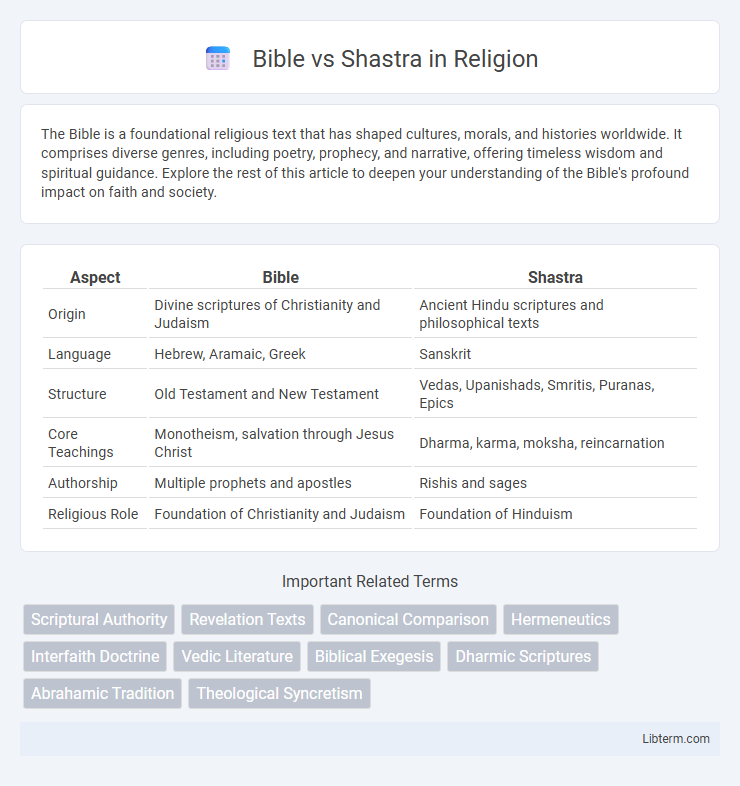The Bible is a foundational religious text that has shaped cultures, morals, and histories worldwide. It comprises diverse genres, including poetry, prophecy, and narrative, offering timeless wisdom and spiritual guidance. Explore the rest of this article to deepen your understanding of the Bible's profound impact on faith and society.
Table of Comparison
| Aspect | Bible | Shastra |
|---|---|---|
| Origin | Divine scriptures of Christianity and Judaism | Ancient Hindu scriptures and philosophical texts |
| Language | Hebrew, Aramaic, Greek | Sanskrit |
| Structure | Old Testament and New Testament | Vedas, Upanishads, Smritis, Puranas, Epics |
| Core Teachings | Monotheism, salvation through Jesus Christ | Dharma, karma, moksha, reincarnation |
| Authorship | Multiple prophets and apostles | Rishis and sages |
| Religious Role | Foundation of Christianity and Judaism | Foundation of Hinduism |
Introduction: Exploring Sacred Texts
The Bible, a foundational scripture for Christianity, encompasses the Old and New Testaments, offering historical narratives, moral teachings, and spiritual guidance. Shastras, ancient Indian scriptures including the Vedas, Upanishads, and Dharma Shastra, provide comprehensive insights into philosophy, law, and rituals central to Hindu tradition. Both texts serve as authoritative sources shaping cultural values and religious practices across diverse communities worldwide.
Historical Origins: Bible and Shastra
The Bible, comprising the Old and New Testaments, originated between 1200 BCE and 100 CE within the ancient Near Eastern context, reflecting Judaic traditions and early Christian writings. In contrast, Shastras are a broad category of Sanskrit scriptures composed between 1500 BCE and 500 CE in ancient India, encompassing texts like the Vedas, Upanishads, and Dharmashastras that guide religious, philosophical, and social practices. Both scriptures hold foundational roles in shaping their respective religious and cultural histories, evidencing distinct historical origins rooted in the Near East and Indian subcontinent.
Core Philosophies: Monotheism vs. Polytheism
The Bible emphasizes monotheism, centering on belief in a single, all-powerful God who governs the universe and guides moral conduct, as seen in passages like Deuteronomy 6:4 ("Hear, O Israel: The Lord our God, the Lord is one"). In contrast, many Shastras, integral to Hindu scripture, describe a complex polytheistic framework featuring multiple deities representing various aspects of the divine, such as Brahma, Vishnu, and Shiva, each embodying distinct cosmic functions. This fundamental difference shapes religious rituals, cosmology, and philosophical outlooks, with monotheism stressing unified divine authority and polytheism embracing diverse manifestations of spiritual power.
Key Figures and Authors
The Bible comprises diverse books authored by multiple figures such as Moses, David, Solomon, Isaiah, and the Apostles Paul and John, reflecting various historical periods and theological perspectives. The Shastra, particularly in Hindu tradition, includes texts like the Vedas, Upanishads, and epics attributed to sages such as Vyasa, Valmiki, and Valmiki, conveying philosophical doctrines and rituals. Both scriptures emphasize teachings from revered figures whose writings shape their respective religious beliefs and practices.
Structure and Composition Differences
The Bible is a compilation of 66 books divided into the Old and New Testaments, written over centuries by multiple authors in various literary genres including history, poetry, prophecy, and letters. In contrast, the Shastras, particularly Hindu scriptures like the Vedas, Upanishads, and Smritis, consist of hymns, philosophical discourses, and ritual guidelines traditionally composed in Sanskrit with a focus on oral transmission and memorization. The Bible's linear narrative structure contrasts with the Shastras' cyclical and thematic approach, emphasizing dharma and cosmic principles over historical chronology.
Moral Teachings and Ethical Frameworks
The Bible emphasizes moral teachings centered on love, forgiveness, and charity, establishing ethical frameworks based on the Ten Commandments and the teachings of Jesus Christ. Shastra, encompassing texts such as the Manusmriti and Bhagavad Gita, provides detailed guidelines on dharma (duty), karma (action), and righteousness, shaping individual and societal conduct. Both scriptures serve as foundational sources of moral values, guiding behavior through divine principles and cultural contexts.
Influences on Culture and Society
The Bible has profoundly shaped Western culture, influencing literature, art, legal systems, and moral values through its narratives and teachings on ethics and human behavior. The Shastras, encompassing Hindu scriptures like the Vedas and Dharma Shastra, have guided social norms, rituals, and laws in South Asia, deeply embedding principles of dharma and karma in daily life and governance. Both texts serve as foundational sources for their respective societies, fostering distinct worldviews and practices that continue to impact cultural identity and social structures globally.
Practices and Rituals: Scriptural Foundations
The Bible emphasizes faith-based practices such as prayer, baptism, and communion rooted in the New Testament's teachings, while Shastras, including the Vedas and Upanishads, provide detailed ritualistic guidelines like yajnas (sacrificial fire ceremonies) and daily pujas. Biblical rituals often symbolize spiritual salvation and covenant with God, whereas Shastra rituals emphasize dharma, karma, and cosmic order through prescribed mantras and offerings. Both texts serve as foundational frameworks guiding religious observances, shaping communal and individual worship within their respective traditions.
Interpretations and Translations
The Bible has undergone extensive translations into hundreds of languages, with interpretations influenced by historical, cultural, and denominational contexts, leading to diverse theological perspectives. In contrast, the Shastra, primarily rooted in Sanskrit texts like the Vedas and Upanishads, relies heavily on traditional commentaries and oral transmission for interpretation, often limiting translations to select scholarly circles. Both texts face challenges in preserving original meanings while adapting to contemporary understanding, highlighting the complexity of scriptural exegesis across linguistic and cultural boundaries.
Enduring Relevance in the Modern World
The Bible and Shastra continue to hold enduring relevance in the modern world due to their foundational ethical teachings and spiritual guidance across diverse cultures. Both texts offer timeless wisdom that addresses fundamental human experiences, moral dilemmas, and the pursuit of meaning, making them pertinent in contemporary discussions on values and societal norms. Their influence persists in shaping personal beliefs, legal systems, and cultural traditions globally, demonstrating their ongoing impact on modern life.
Bible Infographic

 libterm.com
libterm.com